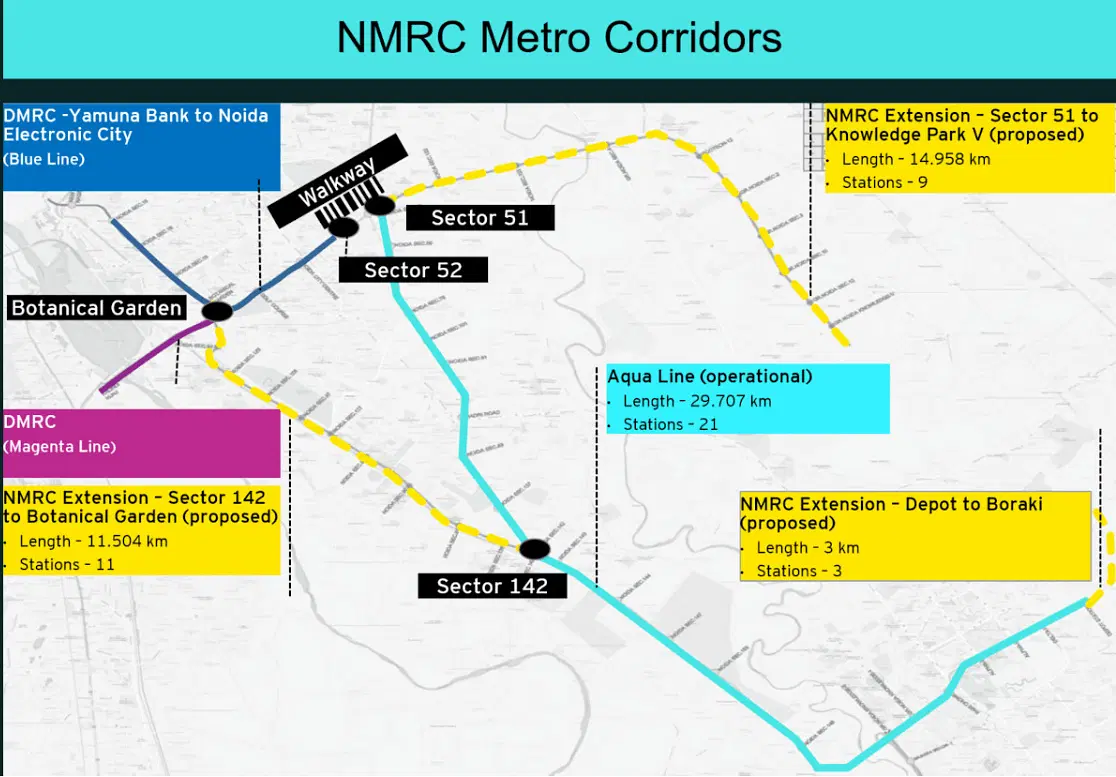The Uttar Pradesh government has approved the detailed project report (DPR) for a new extension of the metro line from Delhi Metro’s Botanical Garden station to Noida’s Sector-142 (Aqua Line), near the Noida-Greater Noida Expressway.
This much-awaited corridor aims to directly connect several emerging and important areas in the Noida-Greater Noida region with Delhi and is now awaiting the next stage of approval from the central government.
The new corridor from Botanical Garden to Sector-142 is designed to meet the growing demand for efficient and reliable public transportation.
Currently, the Aqua Line of the Noida Metro is the only metro corridor connecting Noida and Greater Noida areas.
The Aqua Line, managed by the Noida Metro Rail Corporation, operates separately from the Delhi Metro Rail Corporation’s network. The single operational line spans 21 stations and a total length of 29.7 km.
This corridor, however, covers only a small part of these cities, an area with a high demand for public transit due to the continuous growth of offices and business parks of global conglomerates, high density residential spaces, and upcoming real estate projects.
Adding to the region’s local population, a large number of commuters travel daily from Delhi and other parts of the NCR to work in this region.
However, it lacks good integration with the Delhi Metro network, which carries the majority of commuter traffic to these cities.
To transfer between the two lines, passengers have to exit one line’s facility, walk 300 metres, and enter again with a different access card to the other facility.
Consequently, many commuters choose to avoid the Aqua Line entirely, ending their metro journey at the last stations of the Blue or Magenta Line, such as Botanical Garden.
This situation has led to congestion at specific stations, where commuters disperse in large numbers to farther sectors, mainly to large corporate parks and housing complexes. This transit is managed through shuttle buses, local shared autos, or private taxis.
Due to such conditions, most transit in these twin cities relies on private vehicles, while public transit remains limited.
Thus, more expansion networks are required to achieve well-integrated network, bringing together connections between the Noida metro with the Delhi Metro corridors.
The introduction of the new nearly 12 km link will ensure a better direct connection for the farther regions of Noida and Greater Noida to come closer to Delhi and is expected to significantly increase ridership numbers.
This connection will directly link with Delhi’s Blue Line and Magenta Line — at Botanical Garden, which will serve as an interchange station between NMRC’s Aqua Line and Delhi Metro’s two lines.
It will allow commuters, who previously had to get down at Botanical Garden and struggle to use different modes of transport to reach their destinations in Noida and Greater Noida, to conveniently reach via metro to these areas.
Looking at the larger connectivity plan, the new extension will provide the local population with increased convenience in accessing major railway stations in Delhi through the Blue Line.
Additionally, it is a step further in improving metro connectivity to the Indira Gandhi International Airport via the Magenta Line of the Delhi Metro and opens up potential extension plans to reach the upcoming Noida International Airport in Jewar.

The NMRC had roped in Delhi Metro Rail Corporation (DMRC) for the DPR of this network.
The Uttar Pradesh government has approved a budget of Rs 2,254.35 crore for this extended corridor — which will feature eight new stations — Botanical Garden, Noida Sector-44, Noida Office, Noida Sector-97, Noida Sector-105, Noida Sector-108, Noida Sector-93, and Panchsheel Balak Inter College.


